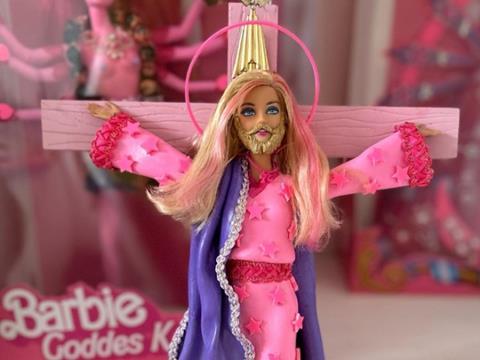Christians have unsurprisingly objected to plastic dolls which depict Jesus as Barbie. But Dr Peter Harris believes there are spiritual lessons to be gleaned from this controversial artistic stunt

Two Argentinian artists have recently come in for extensive criticism from the faithful for depicting Jesus and other scriptural figures as Barbie and Ken dolls.
The dolls are the product of Emiliano Pool Paolini’s and Marianela Perelli’s imaginations and are not endorsed by the makers Mattel. In the eyes of some Christians, these Barbies are blasphemous.
The two artists clearly want to make money from their dolls. They began their religious Barbies back in 2014 and have enlarged their collection to coincide with Greta Gerwig’s hit film.
The dolls sell for on average $750 (£587). The collection includes Barbie and Ken nailed to pink crosses, a Virgin Mary Barbie, a Moses Ken and a Barbie nativity scene. Other religious figures have been depicted such as a Buddha Ken.
The dolls sit within a controversial artistic tradition of mixing the sacred with the profane. Take, for example, the 1979 film The Life of Brian which parodied the life of Jesus, and attracted widespread anger from Christians at the time.
The question is: can there be any other reactions to these artistic stunts, aside from us Christians denouncing them as blasphemous? The answer is indeed yes.
Another view
At a time when we are told that the Christian story is dying out in an increasingly secular West and that young people have no notion of the biblical narratives, the fact that two artists have taken contemporary icons such as Barbie and Ken and presented them through the details of the Virgin Birth and the crucifixion suggests that Christian culture is not as dead as it is said to be.
The fact that it is the world’s media that is interested in this story and not just Christians demonstrates an abiding knowledge of axiomatic Christian beliefs and events.
Jesus Barbies and Kens also provide a way in to talking with those who do not believe what Christians believe. Like the New Atheists whose best-selling books put the topic of God back in the mainstream, so too can pink dolls nailed to pink crosses. Imagine having the opportunity of saying the following: “I too have seen those crucified dolls that look like Jesus. No, they don’t offend me. Let me tell you the real reasons why Jesus allowed himself to be crucified.” These dolls can be the doorway to conversations about the crucifixion that really matters.
These dolls can be the doorway to conversations about the crucifixion that really matters
The artists have called their doll collection ‘Plastic Religion.’ The title synthesises the essence of Barbie culture which is all about plasticity, artificiality and superficiality with the immutable, authentic, profound world of religion. It is an uneasy combination, but it carries with it an important warning to certain Christians who are caught in an actual plasticised version of the faith. I believe Barbie is symbolic of a commercialised, materialistic lifestyle which has infected the Church in the form of the prosperity Gospel. This warped teaching presents relationship with God not as an end in itself, but as a means to health and wealth. God is your heavenly credit card which you operate through your prayers to have the house, car and clothes of your dreams and the good thing is that you do not have to pay off the credit card as God forgives all your debts. As you would expect, the high priests of this movement make a lot of cash out of it. As mediators of God’s largesse, they promise that if you sow money like seed into their ministries, God will bless you with a harvest of wealth. It is laughably untrue, and yet tragically, the naïve faithful believe it even when the only ones getting rich are the big, fat ministries they give to.
Barbie world is about personal image rather than substance which like plastic can be moulded and melded into whatever you want to be that day. Likewise, image rather than substance has become integral to some elements of evangelical Christianity. Historically, evangelicalism has distrusted religious imagery such as statues, icons and stained-glass windows as idolatry. Regardless of whether traditional religious iconography is an aid to contemplation or the road to damnation, what some evangelical Christians, particularly though not exclusively in the US, have put in its place is crass idolism. Take, for instance, the celebrity pastor, an oxymoron indeed. Usually, the head pastor of a megachurch whose congregants number in their thousands. The pastor is the Sunday morning superstar wowing with his photogenic looks and unbuttoned shirts that hint at tanned slabs of pectoral muscle. His sermons are theologically ignorant, but his public relations department is highly skilful. There is no time to talk with him over coffee at the end because his private jet is waiting to take him to a handsomely paid conference somewhere over the rainbow. He is the shepherd who does not feed the sheep with God’s word, but who feeds on his congregation’s awe.
Hang on…
But surely the crucified Barbie and Ken dolls are a step too far?
Are they not a grotesque parody of the crucifixion that along with the resurrection is the most holy event in human history?
That is one way of looking at it, but Barbie and Ken on the cross can speak in a different way for they represent what has happened to Christians spiritually and what God calls them to do daily.
The apostle Paul teaches that Christians’ old selves were “crucified with him” so that their bodies of sin “might be done away with” and that they “would no longer be slaves to sin” (Romans 6:6). Moreover, Paul declares that “those who belong to Christ Jesus have crucified the flesh with its passions and desires” (Galatians 5:24). If Barbie and Ken are the plastic idols of materialism and consumerism, their crucifixion is not sacrilegious, but is a symbolic reminder to believers that the sinful power of materialism and consumerism has been broken by the cross and that these desires are to be crucified daily.
The question now is whether Emiliano Pool Paolini and Marianela Perelli are brave enough to depict a resurrected Barbie and Ken, not of course as a mockery of the risen Jesus, but as an invitation to discipleship and one of its post-mortem rewards: the reunion of deceased believers with their truly perfected bodies at the Eschaton.


































1 Reader's comment